
Paradoxides is a genus of large to very large trilobite found throughout the world during the Middle Cambrian period. One record-breaking specimen of Paradoxides davidis, described by John William Salter in 1863, is 37 cm (15 in). The cephalon was semicircular with free cheeks ending in long, narrow, recurved spines. Eyes were crescent shaped providing an almost 360° view, but only in the horizontal plane. Its elongate thorax was composed of 19–21 segments and adorned with longish, recurved pleural spines. Its pygidium was comparatively small. Paradoxides is a characteristic Middle-Cambrian trilobite of the 'Atlantic' (Avalonian) fauna. Avalonian rocks were deposited near a small continent called Avalonia in the Paleozoic Iapetus Ocean. Avalonian beds are now in a narrow strip along the East Coast of North America, and in Europe.
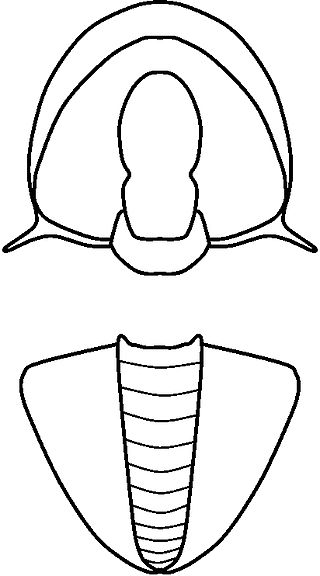
Acidiscus Rasetti, 1966, is a genus of Eodiscinid trilobite belonging to the family Weymouthiidae Kobayashi T. (1943), Order Agnostida Salter (1864). It lived during the Botomian stage = late Lower Cambrian Stage 4 ; the upper Botomian boundary corresponds to base of the Middle Cambrian, Miaolingian Series and Wuliuan stage.

Acimetopus Rasetti, 1966, is a genus of Eodiscinid trilobite belonging to the family Weymouthiidae Kobayashi (1943), Order Agnostida Salter (1864). It lived during the Botomian stage. = late Lower Cambrian Stage 4 ; the upper Botomian boundary corresponds to base of the Middle Cambrian, Miaolingian Series and Wuliuan stage.

Analox Rasetti, 1966 is a genus of Eodiscinid trilobites belonging to the family Weymouthiidae Kobayashi T. (1943), Order Agnostida It lived during the Botomian stage. It can easily be distinguished from other trilobites by the two furrows that extend forwards and sidewards from the front of the glabella.
Leptochilodiscus Rasetti, 1966 [= Kerberodiscus Bassett et al., 1976] is a genus of Lower Cambrian Eodiscinid trilobite belonging to the family Weymouthiidae Kobayashi (1943), Order Agnostida. It lived during the Botomian stage = late Lower Cambrian Stage 4 ; the upper Botomian Stage boundary corresponds to base of both the Middle Cambrian Wuliuan stage and Miaolingian Series.
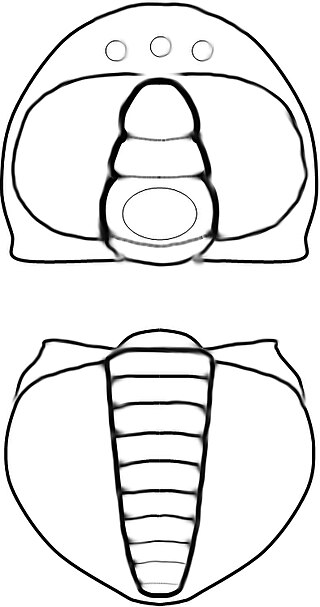
Ninadiscus Korobov, 1980, is a genus of Eodiscinid trilobite belonging to the family Weymouthiidae Kobayashi (1943), Order Agnostida Salter (1864). It lived during the Botomian Stage = late Lower Cambrian Stage 4 ; the upper Botomian boundary corresponds to the base of the Middle Cambrian, the Miaolingian Series and Wuliuan Stage.
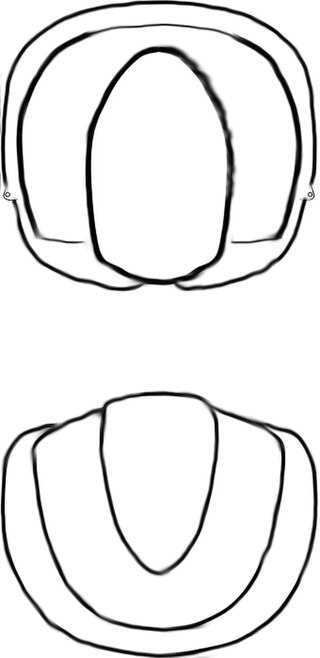
Oodiscus is an extinct genus of small size trilobite, with three known species. It lived during the Toyonian in what are now Canada and the USA.
Stigmadiscus Rasetti, 1966, is a genus of Lower Cambrian Eodiscinid trilobite belonging to the family Weymouthiidae Kobayashi (1943) Order Agnostida It lived during the Botomian stage, = late Lower Cambrian Stage 4 ; the upper Botomian Stage boundary corresponds to base of both the Middle Cambrian Wuliuan stage and Miaolingian Series.
Meniscuchus is an extinct genus from a well-known class of fossil marine arthropods, the trilobites. It lived during the Botomian stage, which lasted from approximately 522 to 516 million years ago. This faunal stage was part of the Cambrian Period. Meniscuchus has been found in the USA, Canada, Russia and Australia.
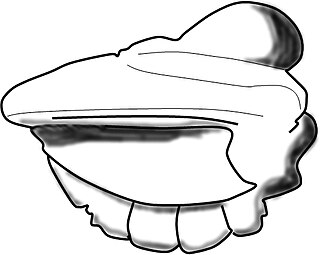
Chelediscus Rushton, 1966, is a genus of Eodiscinid trilobite belonging to the family Weymouthiidae Kobayashi T. (1943), Order Agnostida Salter (1864). The Treatise assigns this genus to the Calodiscidae; Cotton and Fortey (2005) however move it to the Weymouthiidae. Chelediscus lived during the later part of the Botomian stage.

Tsunyidiscus is a trilobite belonging to the Suborder Eodiscina. Tsunyidiscus appeared near the end of the Lower Cambrian, during the late Atdabanian stage of geologic time and some collections suggest it may have survived into the Botomian. The genus is very small, oculate and isopypous with a narrow dome-shaped glabella and a narrow bullet-shaped pygidial axis. Thorax consists of three segments. Tsunyidiscus is the only genus currently attributed to the family Tsunyidiscidae.

Pagetia is a genus of small trilobite, assigned to the Eodiscinid family Pagetiidae and which had global distribution during the Middle Cambrian. The genus contains 55 currently recognized species, each with limited spatial and temporal ranges.
Yukoniidae S. Zhang, 1980 [nom. transl. et emend. Jell, in Whittington et al., 1997 ex Yukoniinae S. Zhang in W. Zhang, Lu et al., 1980] is a small family of trilobites, belonging to the Eodiscina.
Lotagnostus is a genus of very small trilobites in the order Agnostida, which lived on the outer continental shelves worldwide, during the late Upper Cambrian. It was described by Whitehouse in 1936, and the type species is Lotagnostus trisectus, which was originally described as a species of Agnostus by Salter in 1864.
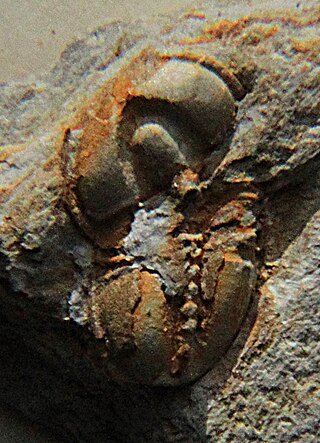
Eodiscina is trilobite suborder. The Eodiscina first developed near the end of the Lower Cambrian period and became extinct at the end of the Middle Cambrian. Species are tiny to small, and have a thorax of two or three segments. Eodiscina includes six families classified under one superfamily, Eodiscoidea.

Marocconus is an extinct genus from a well-known class of fossil marine arthropods, the trilobites. It is still debated if it lived at the very end of the Lower Cambrian or at the very beginning of the Middle Cambrian. Marocconus notabilis is the only known species in this genus.
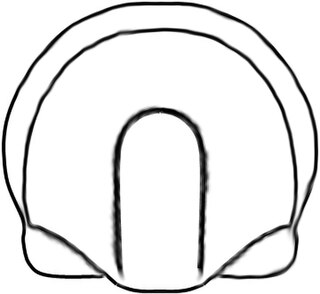
Mallagnostus Howell, 1935, is a trilobite genus belonging to the family Weymouthiidae Kobayashi T. (1943), Order Agnostida Salter (1864) according to Whittington et al. 1997. It lived during the late Lower Cambrian, with remains found in USA, Canada (Newfoundland), Spain, England, Russia, Mongolia, and the early Middle Cambrian as reported from China and Russia (Yakutia).

The Weymouthiidae Kobayashi 1943 are an extinct family of eodiscinid agnostid trilobites. They lived during the late Lower Cambrian and earliest Middle Cambrian in the so-called Olenellus- and Eokochaspis-zones in the former paleocontinents of Laurentia, Avalonia, Gondwana. The Weymouthiidae are all blind and lack free cheeks.
Tannudiscus Pokrovskaya (1959) is a genus of Eodiscinid trilobites belonging to the family Weymouthiidae Kobayashi T. (1943), Order Agnostida. It lived during the late Lower Cambrian, with remains found in Canada (Newfoundland), China (Gansu), The United Kingdom (England), and the Russian Federation.

Serrodiscus Richter and Richter 1941. is a genus of Eodiscinid trilobite belonging to the family Weymouthiidae Kobayashi T. (1943), Order Agnostida. It lived during the late Lower Cambrian, with remains found in Canada, China (Gansu), The United Kingdom (England), Germany (Silesia), Poland, the Russian Federation, and the United States. It is named for the spines on the ventral side of the pygidium, which give it a serrated impression.













